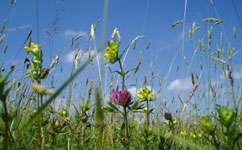Parasitic plants, sworn enemy of many a farmer, can carry surprising benefits for wildlife, according to new research.
The study, published in New Phytologist, focuses on the partially parasitic plant, Rhinanthus Minor, commonly known as Yellow Rattle, whose destructive potential is well documented.
'Rhinanthus is a non-discriminate attacker,' says Dr Duncan Cameron of the University of Sheffield, one of the study's authors. 'It's like warfare in the soil but most of us have no idea what's going on down there.'
'If it comes across something that looks like a root, even if it's a twig, its own roots act like a hand to grab onto the host root and pull it apart.'
'It starts to suck water from the host plant and steals its nitrogen and phosphorous nutrients. Essentially it hijacks the route system, it's really quite unpleasant.'
But Cameron and his UK team of researchers including former NERC-funded PhD student, Dr James Fisher, have discovered new perks to Rhinanthus, packaged in the leaves it drops as litter.
'Rhinanthus drops leaves that are full of nutrients, whereas normally plants withdraw the nutrients before they release the leaves,' says Cameron. 'This means that Rhinanthus produces very nutrient-rich litter.'
'We find that the litter from Rhinanthus improves nutrient cycling in the soil and encourages a greater variety of life by supressing grasses and promoting herby flowering plants.'
But if you're looking for a pristine patch of green grass, Rhinanthus might not be for you, warns Cameron.
'If you're after the perfect, mono-species lawn, then you would definitely want to yank it out,' he says. 'But if you're trying to restore a species-rich meadow then, depending on your soil and plant species, you might want to leave it in.'
'Over the last couple of centuries we've lost 90 per cent of our grass meadows because people have been using nitrogen fertilizers on the land.'
'Introducing Rhinanthus could massively speed up the slow natural process of getting rid of that fertilizer and encourage biodiversity in our grasslands.'
Benefits for farmers
Previous research had relied heavily on pot experiments, examining what happened when you planted a Rhinanthus plant next to a host.
But the team wanted to make sure their experiments matched the reality of a grassy meadow as closely as possible.
'Most pot studies predicted Rhinanthus would be absolutely devastating, but when you get out into the field, that never seems to be the case,' says Cameron.
'We built meadows in the lab, making them as realistic as possible but controlling the litter input.'
The research could bring benefits for farmers, who are paid subsidies by the European Union to encourage a greater variety of life on their land.
Cameron and his team are now hoping to develop an online tool that land owners could use to see whether or not their meadows could benefit from Rhinanthus.
'A gardener or farmer could plug in some information about their soil and the species on their meadow, and then we could tell them what effect Rhinanthus is likely to have on their biodiversity,' he explains.
More information: Fisher, J. et al. Parasitic plant litter input: a novel indirect mechanism influencing plant community structure, New Phytologist, 2013, doi: 10.1111/nph.12144
Journal information: New Phytologist
Provided by PlanetEarth Online
This story is republished courtesy of Planet Earth online, a free, companion website to the award-winning magazine Planet Earth published and funded by the Natural Environment Research Council (NERC).





















